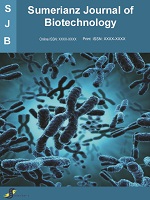Sumerianz Journal of Biotechnology

Online ISSN: 2617-3050
Print ISSN: 2617-3123
Quarterly Published (4 Issues Per Year)
Journal Website: https://www.sumerianz.com/?ic=journal-home&journal=32Archive
Volume 3 Issue 11 (2020)
Growth Response of Clarias gariepinus (North African Catfish) Under Varying Feeding Rates
Authors : Ofonime Edet Afia ; David Oristeseyi Kolawole ; Gift Samuel David
DOI : doi.org/10.47752/sjb.311.113.117
Abstract:In fish farming, feeding rate is an important factor affecting the growth of fish, and thus determining the optimal feeding rate is important to the success of any aquaculture operation. This study which lasted for 99 days investigated the effect of varying feeding rates on the growth response of African catfish, Clarias gariepinus fingerlings. One hundred and eighty fingerlings were randomly distributed into nine experimental tanks giving 20 fingerlings per tank with an initial weight of 5.92±0.006 g. Three feeding rates were employed as treatments – 3%, 5%, and 7% of fresh body weight, with three replicates per treatment. The fishes were fed three times daily with commercial feed (Aller-aqua) of 42% crude protein. Growth and water quality parameters were measured fortnightly and feed ration adjusted according to the biomass in each tank. Results show that Final Mean Weight, Mean Weight Gain, Specific Growth Rate, Performance Index and Protein Efficiency Ratio were significantly higher (p<0.05) in fish fed 7%. However, Feed Conversion Ratio were better at 3% body weight (p<0.05). Based on the growth performance and feed efficiency data obtained, the study suggests the optimum feeding rate of 5% bw/day for African catfish, C. gariepinus fingerlings.
Bioassay Essential Oils on Tribolium castaneum and Tribolium confusum (Coleoptera: Tenebrionidae)
Authors : Magda Mahmoud Amin Sabbour
DOI : doi.org/10.47752/sjb.311.106.112
Abstract:Background: Tribolium confusum and Tribolium castaneum are pests spread inside the stores and homes. These pests infest stored grains and many others seeds in the stores and bakery. These controlled by insecticides. The essential have a promising research results in controlling these pests and decreasing the insect infestations. The natural essential oils have a low effect on the human, non-target insects, and do not pollute the environments. This research is an alternative approach to natural control these two stored product pests. Methods: Four essential oils namely, Lantana camara, Acorus calamus, caraway oil and Ammi majus were estimated on two stored product insects T. confusum and T. castaneum. Encapsulation method by the technology of polymerization was followed. The nano oils at 0.5% were estimated on the 3rd larval instars. Percentages of accumulative mortality were calculated after seven days of the experiments. The effect of nano-oils on oviposition experiments made by spraying two grams of foams of the tested oils and their nano formulations mixed with 100 gram of wheat. Results data obtained detected that, the Percentage of larval mortality increase by increasing the concetrations for both insects T. confusum and T. castaneum. T. confusum tested larvae were more susceptible to the treatments than T. castaneum larvae. Nano A. majus oil showed a stronger effecte than that L. camara or A. calamus oil. Adult emergence percent and fecundity showed a highly decreasing after treatments with nano-oil L. camara, A. calamus, A. majus oils under storage conditions, compared to those of the controls or non-nano-oils. The results suggested that nano A. majus can be used as a valuable tool in pest management programs of T. confusum and T. castaneum Conclusion: The results of this work indicate that some essential oils might be helpful management of pests in the stores because of their fumigant and odor action. Essential oils of plant origin contain active ingredients which are effective against many insects. Nano formulations of essential oils, through controlled release, prevent speed violate and decay and, also increase the stability of the oils. Treated foam, using L. camara, A. majus, caraway, and A. calamus oils gave protectthe wheat seeds from two pests infestations.


